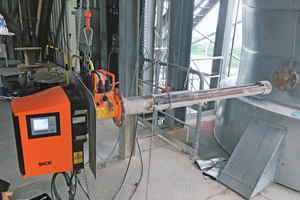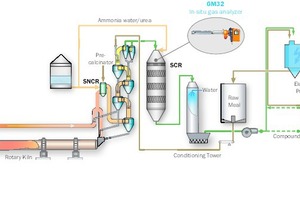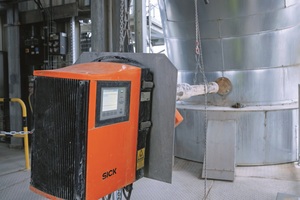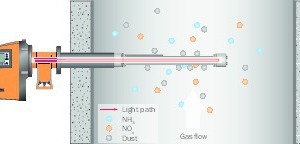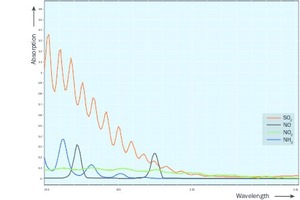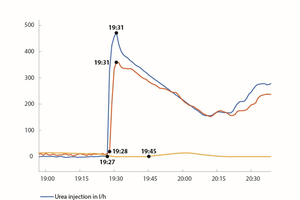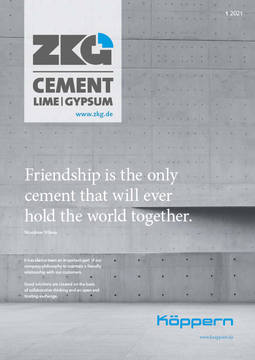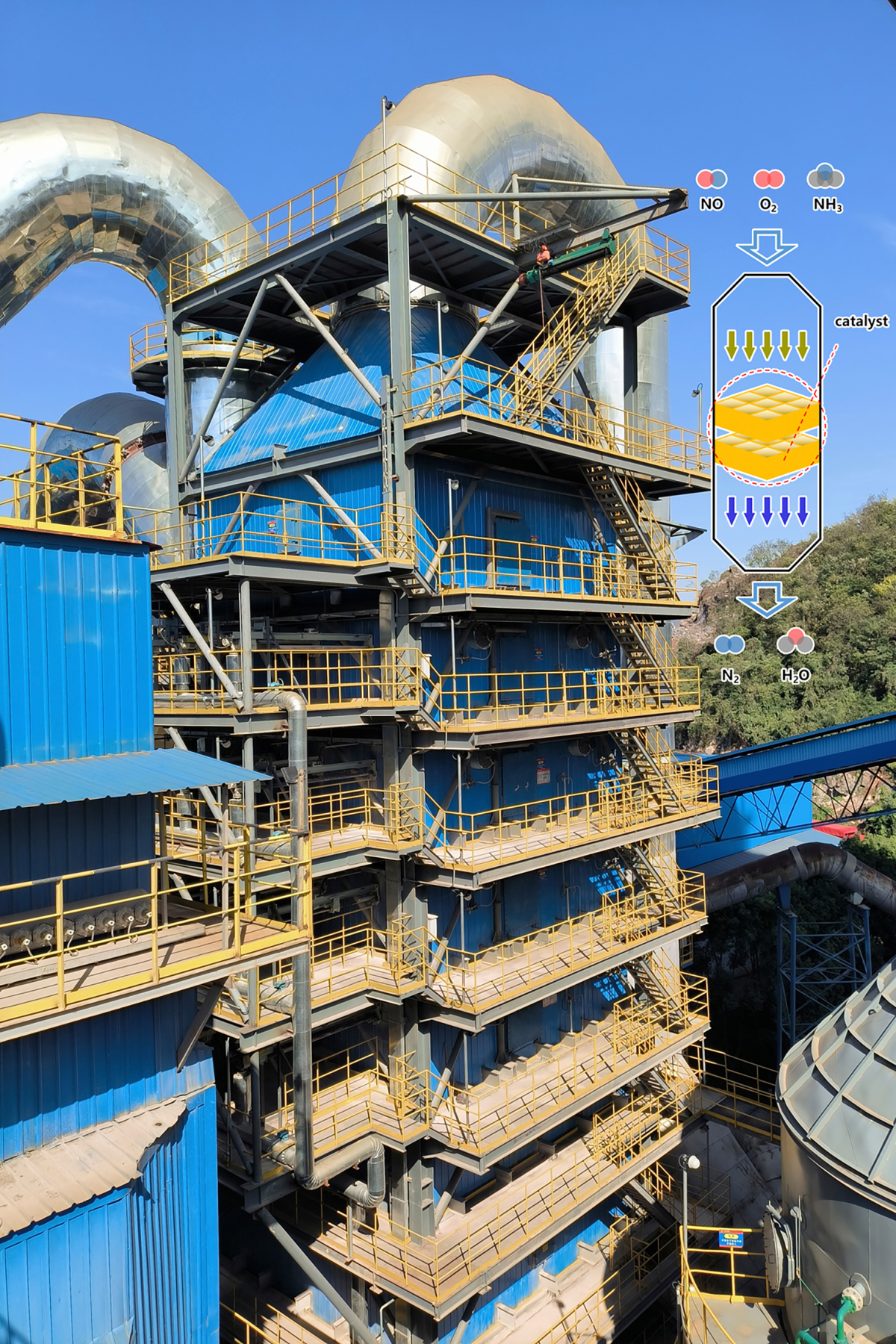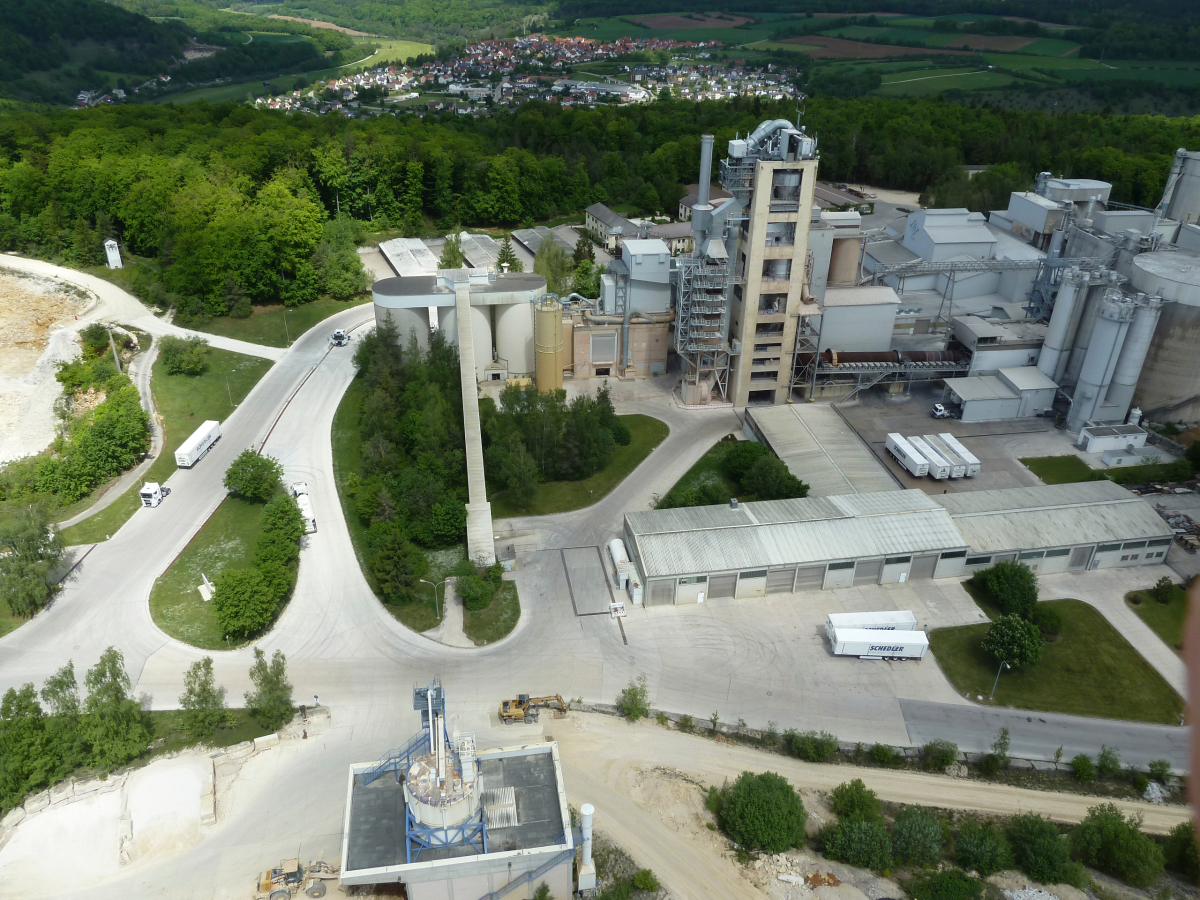In situ gas analyser controls NOx for fast process controlling
During the clinker burning process in the cement production NOx can be formed. To prevent the formation of nitric acid or acid rain in nature the NOx in the exhaust gases must be reduced by the combustion of NOx e.g. by SCR or SNCR. The emission guideline 17. BlmSchV limits the NOx concentration in gas emissions. For an effective operation of the SCR or SNCR systems a fast in situ gas analysis is necessary.
NOx emissions and regulations
Nitrogen oxides (NOx) and other nitrogen compounds arising from cement production are considered the main reason for photochemical smog and formation of nitric acid and acid rain. They are formed either by a combination of fuel-based nitrogen with oxygen within the flame or by a combination of atmospheric nitrogen in the combustion air. The two main mechanisms for the production of NOx in a clinker burning process are the reaction of nitrogen in combustion air at high temperatures (thermal NOx) and the combustion of nitrogen-containing fuels (fuel NOx). Globally the emission limits for NOx show the same trend towards lower emission standards and stricter penalties for non-complying plants. However, there are still big differences for this pollutant. Most national limits are in the region of 500 to 1000 mg/Nm3. Some plants in the EU take pioneering roles by having fixed emission limit values of down to 200 mg/Nm³, depending on which kiln process is applied and what type of fuels are being used.
Even though primary measures such as flame cooling, installation of low-NOx burners, staged combustion and general process optimizations show significant effects in reducing NOx emissions, secondary measures are seen as vital for NOx abatement and lower emission limit values. In cement production two secondary measures, selective catalytic reduction (SCR) and selective non-catalytic reduction systems (SNCR), have constantly gained in popularity over the last years and are accepted and proven technologies when controlled in a proper way.
SCR and SNCR – two technologies, one goal
SCR and SNCR denitrification (DeNOx) plants use ammonia (NH3) for an efficient reduction of NOx to form the harmless nitrogen and water. The main difference between both technologies is the use of a catalyst. The SNCR, i.e. DeNOx without a catalyst, is installed in the riser duct or calciner after the rotary kiln at a temperature range of 900 to 1000° C. Depending on the type of the SCR it can be placed in the high dust raw gas stream (e.g. directly after the preheater) or before the main stack in the low dust gas stream as a so-called tail-end or low-dust SCR. An SCR consists of a specific number of catalyst layers and operates at gas temperature of around 300 to 350° C. The reducing agent, typically ammonia water or urea, is injected at the SCR inlet. For an initial reduction of NOx emission values, often an SNCR is sufficient and lower in cost to install than an SCR. An efficient reaction between the NH3 and NOx depends highly on the temperature. At temperatures greater than 1200° C, NH3 converts to NOx, at temperatures lower than 800° C, the ammonia slip increases. Thus, an efficient and well-adjusted control of the ammonia injection is of great importance for the compliance of gas emission limits when using an SNCR. The presence of the catalyst in the SCR allows the operation at lower temperatures and offers a higher stoichiometric ratio, which leads to a lower amount of injected reducing agent and ensures a lower NH3 slip. Thus, very low NH3 and NOx emission limit values can be adhered to.
The project HeidelbergCement Geseke
With the growing demand for SCR and SNCR units in cement production, the need for a measurement technology that can be used to control these plants efficiently is also increasing. According new emission limits from 01.01.2019, which have been released (17. BImSchV; Federal emission control act), 200 mg/Nm3 for NOx and 30 mg/Nm3 for NH3 is required. To comply with local emission regulations, HeidelbergCement decided to invest in an SCR plant in addition to the already existing SNCR solution. HeidelbergCement Geseke finished the commissioning of the new high dust SCR plant in March 2019.
During planning and implementation of the project, the question of which kind of analyzer could fulfill the requirements for an efficient SCR control was addressed. The device should be placed at the SCR inlet between the ammonia water injection nozzles and the catalyst (see Figure 3).
Of high importance were the fast response time of the analyzer for a very efficient control of the ammonia water injection as well as a long maintenance free period under these very challenging conditions. The advantage of the measuring location at the inlet is the simultaneous measurement of NH3 and NO entering the SCR. Here, NH3 is the sum of ammonia evaporation from the raw materials, the ammonia slip of the SNCR and the ammonia water injection for the SCR. As well, the NO originating from the combustion process could be measured. With this measurement and the Continuous Emission Monitoring System (CEMS) at the main stack as backup, a feed forward control would be possible.
Within the project-planning phase, Heidelberg-Cement contacted Sick to provide a solution, which best fits the requirements mentioned above. As the only provider for all major gas measuring principles and technologies alongside with many years of experience, Sick was able to select and provide the best measuring technology for each application. In this case, Sick decided to provide a GM32 in-situ analyzer in order to cope with the very challenging process conditions – high dust, high temperature and vibrations.
GM32 – the innovative in-situ gas analyzer
The in-situ gas analyzer GM32 from Sick measures simultaneously up to four components (NO, NO2, NH3, SO2) plus temperature and pressure directly inside the process gas stream. The direct measurement inside the duct (in-situ) leads to fast measuring results due to a short response time, which is perfectly suitable for process control. The GM32 analyzer unit is equipped with a gas permeable probe (GPP), which is positioned inside the duct (see Figure 2). Using the wavelength-specific light absorption by the gas mixture on the active measuring path, the sender/receiver unit determines the concentration of the gas components present. UV light sent from the sender/receiver unit passes the active measuring path of the GPP probe and is reflected by a triple reflector at the end of the probe. The permeable filter element – the heart of the GPP – keeps all dust outside of the measuring path, where the light passes through, while the gas permeates quickly through the pores ensuring the required fast response time. The GM32 uses the DOAS principle (Differential Optical Absorption Spectroscopy) where the absorption lines of specific gases in a particular wavelength range are evaluated.
Neither the filter, nor the rest of the gas analyzer require weekly or monthly checking, cleaning or other high frequent maintenance work.
Due to the higher temperature and possible temperature fluctuations at the measuring location, stack movements are possible. With the implemented auto alignment correction, which aligns the light beam continuously during operation, stack movements as well as vibrations can be compensated for. This ensures a stable and reliable measurement.
In comparison to many other measuring systems, which require a frequent test gas calibration, the integrated filters for zero and span check (approved according to EN15267) automatically compensate drifts and ensure a correct and accurate measurement. This helps in addition to keep operational expenditures very low.
After the test run on the long distance
The final commissioning of the in-situ gas analyzer at the HeidelbergCement plant Geseke took place in March 2019 (Figure 3). During the 12-month testing period (March 2019 – March 2020), Sick and the cement plant proved that in this application the GM32 has to be checked regularly only every 9 to 12 months. With the help of remote service (Sick Meeting Point Router), on-site tests were performed and a large amount of additional process data, like the CEMS concentration values at the main stack, was collected and evaluated in various aspects. During the test period it was proven that the analyzer has a stable reaction time of <20 s (Figure 4), without the need of any cleaning and smaller or larger maintenance work. The results show that with a delay of two to 17 minutes (depending on the measuring component) a CEMS alone is not sufficient for DeNOx process control.
Especially the NH3-value for CEMS has a huge delay in comparison to the in-situ process gas measurement (Figure 4), due to the high adsorption of ammonia on surfaces (e.g. filter and heated measurement lines). Controlling the SCR with such delayed measuring values will lead to an excessive injection of ammonia water and a faster exceedance of the NO and NH3 emission limit values at the main stack. Therefore, Sick’s GM32 in-situ measurement device has proven to be the right device for this kind of application.
“We are very satisfied with the performance of the GM32 gas analyzer. The GM32 project was executed fully compliant with the requirements and schedule. We are looking forward to continued good cooperation,” said Dr.-Ing. Steffen Gajewski, Plant Manager & Dipl.-Ing. Stefan Naber, Operations Manager, HeidelbergCement Geseke.
Remote service and condition monitoring
For the future, Sick and HeidelbergCement are planning to implement, Sick’s Monitoring Box in order to offer predictive maintenance services for all gas analyzers and dust measurement equipment installed on-site. The solution allows Sick to optimize maintenance, to monitor critical components or device conditions and to make remote product health inspections that recommend maintenance actions. This will enable immediate troubleshooting, which again reduces travel expenses and labor hours for service engineers. Furthermore, continuous remote condition monitoring combined with remote assistance and agreed response times assure compliance with local emission regulations, process stability and continuous production.
A beneficial partnership in the interest of the environment. Due to the great performance of the GM32 in-situ gas analyzer and the very good cooperation between Sick and the operators of the HeidelbergCement Geseke plant, another HeidelbergCement plant in Germany decided to equip its DeNOx system with two GM32 analyzers for SCR control, too. The commissioning of these devices took place in June 2020. This together with an open and intense information exchange during various environmental and process seminars have contributed to a strong partnership between Sick and HeidelbergCement.

